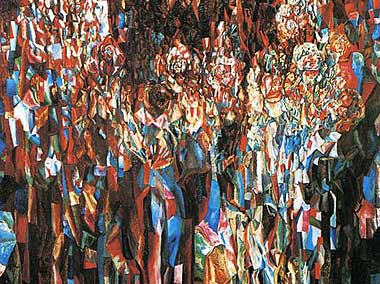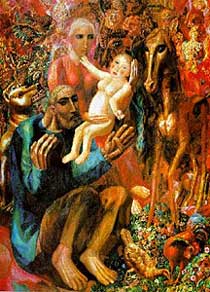|
In "Ideology of Analytical Art" Filonov explains what he expects from his student artists (and, of course, from himself): A work of art is any piece of work made with the maximum tension of "analytical madeness" - "sdelannost". The word is Filonov's neologism, derived from the Russian verb "sdelat'," - to make, to do. Used in its perfective form, the verb denotes the completion of action. The only professional criterion for evaluating a piece of work is its madeness. In their profession the artist and his disciple must love all that is "made well" and hate all that is "not made." In analytical thought the process of study becomes an integral part of the creative process for the piece being made. The more consciously and forcefully the artist works on his intellect, the stronger the effect the finished work has on the spectator. Each brushstroke, each contact with the picture, is a precise recording through the material and in the material of the inner psychical process taking place in the artist, and the whole work is the entire recording of the intellect of the person who made it. Art is the reflection through material or the record in material of the struggle for the formation of man's higher intellectual condition. Art's efficacity vis-a-vis the spectator is equal to this; i.e., it both makes him superior and summons him to become superior. The artist-proletarian's obligation is not only to create works that answer the demands of today, but also to open the way to intellect into the distant future. The artist-proletarian must act on the intellect of his comrade proletarians not only through what they canunderstand at their present stage of development. Work on content is work on form and vice versa. The more forcefully the form is expressed, the more forcefully the content is expressed. Form is made by persistent line. Every line must be made. Every atom must be made; the whole work must be made and adapted. Think persistently and accurately over every atom of the work you are doing. Make every atom persistently and accurately. Introduce persistently and accurately into every atom the color you have studied -- so that it enters the atom just as heat enters the body or so that it is linked organically with the form, just as in nature a flower's cellulose is linked with its color. Painting is the colored conclusion of drawing.
Sources: Bowlt, John E. Russian Art of the Avant-Garde: Theory and Criticism. New York: Thames and Hudson, 1988
Gallery
MAI - Masters of Analytical Art. Association of P.N.Filonov's followers.The association was established in 1925 and was existed officially up to 1932, besides meetings in Filonov's workshop proceeded up to his death in 1941 in Blockade Leningrad. Complement of participants was varying during years. Total number of participants was approximately 70 persons. Here are some significant names of this union:
|


